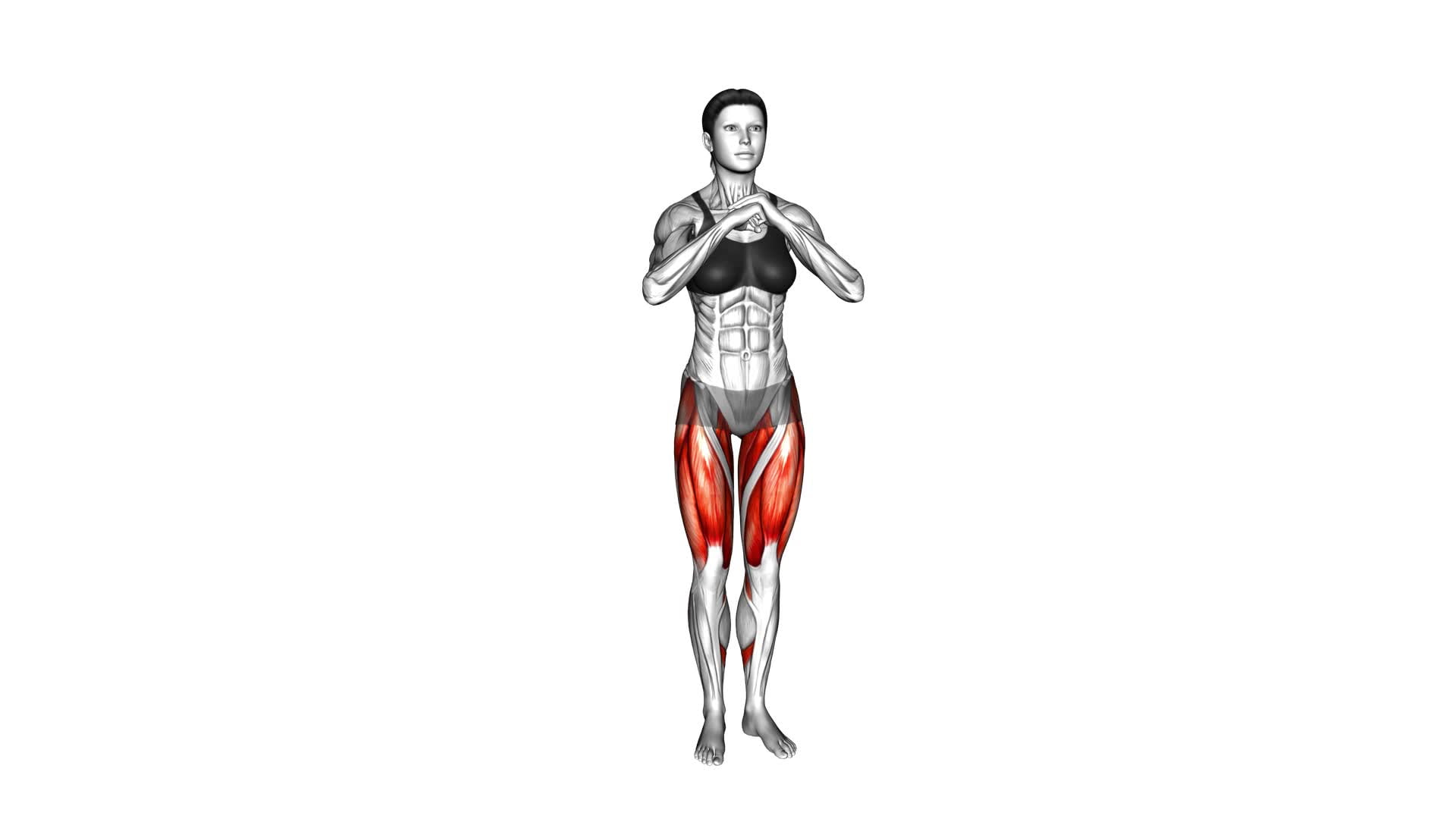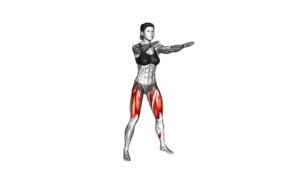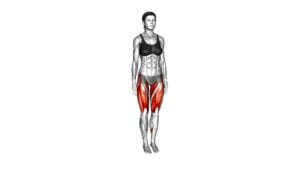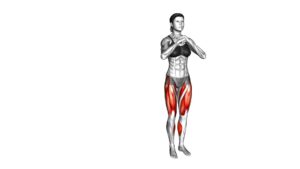Side Squat (female) – Video Exercise Guide & Tips

Get ready to strengthen and tone your legs with the side squat!
Watch This Exercise Video
In this video exercise guide, we'll show you the proper form and technique for performing this effective lower body workout.
Learn how to avoid common mistakes, discover variations and progressions, and get tips for increasing the intensity.
Whether you're a beginner or a fitness enthusiast, incorporating side squats into your workout routine will help you achieve your fitness goals.
Let's get started!
Key Takeaways
- Side squats increase muscle activation in quadriceps, hamstrings, glutes, and adductors.
- Side squats improve lower body strength and tone.
- Side squats enhance balance and stability.
- Side squats support functional movements like running and jumping.
Benefits of the Side Squat
What are the benefits of incorporating side squats into your workout routine?
Side squats offer a multitude of benefits that can enhance your overall fitness and strength. One major benefit is increased muscle activation. When performing side squats, you engage various muscles, including the glutes, quadriceps, hamstrings, and adductors. These muscles work together to stabilize your body and propel you through the movement, resulting in improved strength and tone.
Another benefit of side squats is improved stability. As you perform the exercise, you're required to maintain balance and control, especially when moving laterally. This helps to strengthen the muscles responsible for stability, such as the hip abductors and core muscles. Improved stability not only enhances your performance in other exercises but also reduces the risk of injury during daily activities or sports.
In order to reap the full benefits of side squats, proper form and technique are crucial. By maintaining an upright posture, keeping your knees aligned with your toes, and ensuring proper weight distribution, you can optimize muscle activation and stability. Additionally, utilizing a controlled and controlled range of motion will further enhance the effectiveness of the exercise.
Proper Form and Technique
To perform side squats with proper form and technique, you should start by standing with your feet shoulder-width apart.
Here's a step-by-step guide to help you achieve the correct form and maximize the benefits of this exercise:
- Begin by taking a step to the side with your right foot, keeping your toes pointing forward.
- Lower your body down into a squat position by bending your right knee and pushing your hips back. Your left leg should remain straight and your weight should be evenly distributed between both feet.
- Push through your right heel to return to the starting position, and then repeat the movement on the opposite side.
By performing side squats correctly, you can improve your balance and target your inner thighs effectively. Engaging the inner thighs in this exercise helps to strengthen and tone these muscles, which can enhance overall lower body stability and prevent injuries.
Remember to maintain proper alignment throughout the movement, keeping your chest lifted and your core engaged.
It's important to listen to your body and start with a weight or resistance level that's appropriate for your fitness level. With consistent practice and proper form, side squats can become a valuable addition to your workout routine.
Common Mistakes to Avoid
To avoid common mistakes while performing side squats, focus on maintaining proper alignment and engaging your core throughout the movement.
One common mistake to avoid is allowing your knees to collapse inward. This can put unnecessary strain on your knees and increase the risk of injury. To prevent this, make sure to keep your knees aligned with your toes throughout the entire squat.
Another mistake to avoid is leaning too far forward or backward. This can throw off your balance and compromise the effectiveness of the exercise. Instead, keep your torso upright and your weight centered over your feet.
Additionally, be mindful of your foot placement. Placing your feet too close together can make it difficult to maintain stability, while placing them too far apart can limit your range of motion. Find a comfortable distance that allows you to perform the movement with control and stability.
Remember to always listen to your body and modify the exercise as needed. If you experience any pain or discomfort, consider reducing the range of motion or performing the exercise with the support of a chair or wall.
By avoiding these common mistakes and making modifications when necessary, you can safely and effectively perform side squats.
Now, let's move on to the next section to explore variations and progressions of this exercise.
Variations and Progressions
To continue building on your side squat routine, you can explore various variations and progressions. These different exercises won't only help you challenge your muscles in new ways but also keep your workouts interesting and exciting.
Here are three modifications and adaptations you can try:
- Weighted Side Squat: Once you have mastered the basic side squat, you can add resistance to increase the intensity. Hold a dumbbell or kettlebell in your hands, or place a barbell across your shoulders. This added weight will engage your muscles even more, helping you build strength and endurance.
- Side Lunge to Squat: This exercise combines the side lunge and the squat, giving you a full-body workout. Start by stepping out to the side into a deep lunge, then push off the foot and return to the starting position while performing a side squat. This movement targets your glutes, quads, and hamstrings simultaneously.
- Plyometric Side Squat: If you're looking for a more advanced variation, try incorporating plyometrics into your side squat routine. Instead of stepping to the side, explode off the ground and land in a deep side squat. This explosive movement won't only increase your power but also improve your agility and coordination.
Tips for Increasing Intensity
To further challenge your muscles and take your side squat routine to the next level, consider implementing these tips for increasing intensity.
There are several ways to challenge yourself and make the side squat exercise more difficult. One option is to add weight. Holding a dumbbell or kettlebell in each hand as you perform the side squat will increase the resistance and make your muscles work harder.
If you don't have access to weights, you can also use resistance bands. Wrap the band around your thighs or ankles and perform the side squat while maintaining tension on the band. This will add an extra challenge to the exercise.
Another way to increase intensity is to perform the side squat on an unstable surface, such as a Bosu ball or a balance board. This will engage your core and stabilizer muscles even more.
Lastly, you can modify the side squat for beginners by reducing the range of motion. Instead of squatting as low as possible, start by only squatting halfway down and gradually increase the depth as your strength improves.
Remember to always listen to your body and choose the level of intensity that's appropriate for you.
Incorporating Side Squats Into Your Workout Routine
Now that you understand the benefits of side squats and how to perform them with proper form, it's time to incorporate them into your workout routine.
Side squats can be a great addition to your lower body workout, helping to strengthen your quads, glutes, and inner thighs.
To include side squats in your routine, start by adding them as an accessory exercise after your main compound movements, such as squats or lunges.
Remember to always maintain proper form and engage your core for maximum effectiveness.
Benefits of Side Squats
Incorporating side squats into your workout routine can provide numerous benefits, as they target multiple muscle groups and improve overall lower body strength and stability.
Here are three key benefits of incorporating side squats into your workout routine:
- Increased muscle activation: Side squats engage muscles such as the quadriceps, hamstrings, glutes, and adductors, leading to improved muscle activation and development. This helps to build strength and tone in your lower body.
- Improved balance and stability: Side squats require lateral movement, which challenges your balance and stability. By incorporating this exercise into your routine, you can enhance your ability to maintain control and stability during various activities.
- Functional movement: Side squats mimic movements used in activities like running, jumping, and lateral sports. By including them in your routine, you can improve your overall functional strength and performance in these activities.
Incorporating side squats into your workout routine can offer significant benefits, enhancing muscle activation, improving balance and stability, and supporting functional movements.
Proper Form Tips
To properly incorporate side squats into your workout routine, focus on maintaining proper form and technique.
Start by standing with your feet shoulder-width apart and toes pointing forward. As you squat, shift your weight to one side and lower your body down, keeping your back straight and chest lifted.
Make sure your knee is directly above your ankle and not extending past your toes. Avoid common mistakes such as leaning too far forward or rounding your back.
Additionally, to increase intensity, you can hold dumbbells or a kettlebell at your chest or perform the exercise on an unstable surface like a Bosu ball.
Remember to engage your core and breathe throughout the movement for optimal results.
Frequently Asked Questions
How Many Calories Can I Burn by Doing Side Squats?
You can burn a significant amount of calories by doing side squats.
Side squats are a versatile exercise that targets multiple muscle groups, including your glutes, quads, and inner thighs.
By incorporating variations of side squats, such as adding weights or increasing the speed of your movements, you can further increase the calorie burn.
Remember to maintain proper form and engage your core throughout the exercise to maximize results and prevent injury.
Can Side Squats Help Reduce Cellulite in the Thighs?
Side squats can be effective in reducing cellulite in your thighs. Unlike regular squats, side squats target the inner and outer thigh muscles, helping to tone and firm them. By regularly incorporating side squats into your workout routine, you can improve the appearance of cellulite in your thighs.
To perform a side squat, start with your feet shoulder-width apart, then step to the side and squat down. Remember to keep your back straight and engage your core for maximum effectiveness.
Are Side Squats Suitable for Individuals With Knee Injuries?
Side squats can be beneficial for individuals with knee injuries. They help to strengthen the glutes and improve overall lower body strength.
However, it's important to modify the exercise to avoid putting excessive strain on the knees. To do this, you can decrease the range of motion, use a chair or wall for support, or perform the exercise with resistance bands.
Always listen to your body and consult with a healthcare professional before starting any new exercise routine.
How Often Should I Incorporate Side Squats Into My Workout Routine?
To effectively incorporate side squats into your workout routine, it's important to understand the proper form for this exercise. Side squat variations can be beneficial for building strength in your legs, glutes, and core.
Aim to include side squats in your routine at least two to three times a week. Start with a lighter weight or no weight at all, focusing on maintaining proper form. Gradually increase the difficulty as you become more comfortable and confident with the exercise.
Can Side Squats Help Improve Balance and Stability?
Side squats, compared to traditional squats, can greatly improve your balance and stability. By targeting the muscles in your hips, glutes, and thighs, side squats challenge your body in a different way, ultimately enhancing your athletic performance.
Athletes can benefit from incorporating side squats into their workout routine as they promote lateral movement, which is crucial in many sports. Adding this exercise can help you develop better control over your body and improve your overall stability.
Conclusion
Incorporating side squats into your workout routine can greatly benefit your lower body strength and stability. By properly performing this exercise and avoiding common mistakes, you can maximize its effectiveness.
Additionally, adding variations and progressions can challenge your muscles in new ways. Remember to increase intensity gradually and listen to your body to avoid injury.
Start incorporating side squats into your routine today and experience the benefits for yourself.

Author
Years ago, the spark of my life’s passion ignited in my mind the moment I stepped into the local gym for the first time. The inaugural bead of perspiration, the initial endeavor, the very first surge of endorphins, and a sense of pride that washed over me post-workout marked the beginning of my deep-seated interest in strength sports, fitness, and sports nutrition. This very curiosity blossomed rapidly into a profound fascination, propelling me to earn a Master’s degree in Physical Education from the Academy of Physical Education in Krakow, followed by a Sports Manager diploma from the Jagiellonian University. My journey of growth led me to gain more specialized qualifications, such as being a certified personal trainer with a focus on sports dietetics, a lifeguard, and an instructor for wellness and corrective gymnastics. Theoretical knowledge paired seamlessly with practical experience, reinforcing my belief that the transformation of individuals under my guidance was also a reflection of my personal growth. This belief holds true even today. Each day, I strive to push the boundaries and explore new realms. These realms gently elevate me to greater heights. The unique combination of passion for my field and the continuous quest for growth fuels my drive to break new ground.







